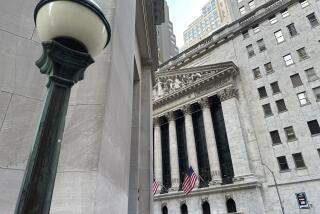Investors Push Bond Prices Down as Sell-Off Continues
- Share via
Take my Treasury bonds -- please!
That increasingly is the cry in the bond market, as the sell-off that began in mid-June continues unabated.
On Tuesday, the yield on the 10-year Treasury note jumped to a one-year high of 4.44%, up from 4.28% on Monday, despite some downbeat economic data that would have been expected to lure buyers to bonds.
The turnaround in yields is fanning fears of a sharp slowdown in the housing market. The stock market, however, so far is taking the rebound largely in stride.
Since interest rates bottomed at generational lows June 13, the 10-year T-note yield has soared 1.33 points as its price has plunged.
Though many analysts expected some backup in bond yields, “The severity of this move has surprised everybody,” said Phil Barach, investment chief for high-grade bonds at money manager TCW Group in Los Angeles.
The rebound is rippling through the economy because Treasury yields are benchmarks for other interest rates. The average 30-year mortgage rate nationwide was 5.94% last week, up from 5.21% in mid-June, according to lending giant Freddie Mac.
Many bond mutual fund owners, meanwhile, have seen the value of their portfolios eroded.
But higher Treasury yields haven’t yet ruffled the stock market much. The Dow Jones industrial average lost 62.05 points, or 0.7%, to 9,204.46 on Tuesday, but it and other key indexes mostly have treaded water since late June.
The Nasdaq composite index slipped 3.99 points, or 0.2%, to 1,731.37 on Tuesday, as winners and losers were nearly even.
Analysts and traders have found no shortage of culprits to blame for the surge in Treasury yields. Some upbeat economic reports have raised expectations that business activity is accelerating, which would be expected to put upward pressure on interest rates -- and drive more investors away from bonds and into stocks.
What’s more, some Federal Reserve officials have appeared to downplay the risk of widespread deflation, or falling prices, in the economy. That fear had helped encourage more investors to buy bonds in the spring, to lock in yields.
The yawning federal budget deficit, which will mean heavy Treasury bond issuance in coming months, also is weighing on the market, analysts say. The Treasury today will spell out its plans for auctions of tens of billions of dollars in securities next week.
But many experts say bond woes primarily amount to a reversal of the wildly bullish sentiment that pushed yields to 45-year lows in mid-June.
As with the Internet-stock boom and bust of 1999-2001, some investors and speculators who loaded up on bonds as they rallied now can’t sell them fast enough as they sink in value.
“Some people are selling because they think others are going to be selling,” said Ethan Harris, chief economist at bond dealer Lehman Bros. in New York.
Meanwhile, potential buyers believe they can take their time, given how quickly yields have resurged -- and given the risk that the sell-off is far from over.
Investors were particularly spooked Tuesday after the Conference Board reported that its index of consumer confidence sank in July. That news initially pushed bond prices up and yields lower by raising the specter of a weaker economy.
“That would have been a logical place for the selling to stop,” Barach said.
But the Treasury dumping resumed again by late morning, snuffing out hopes for a respite.
“We aren’t seeing too many buyers,” said Paul Calvetti, head of Treasury trading at Barclays Capital Inc. in New York. The bonds “are like a hot potato going from one [Wall Street] dealer to another,” he said.
Calvetti pointed to another factor that is driving Treasury yields up: Funds that own mortgage-backed bonds are jettisoning Treasuries to hedge against losses on their mortgage securities. “That just exacerbates the move in yields,” he said.
Still, some bond market pros believe the sell-off may be nearing at least a temporary halt.
Harris said Treasury bonds should begin to look more attractive to investors who expect the economy to continue to struggle over the next year, a view to which he subscribes.
Fundamentally, “you can’t make a case for higher interest rates,” he said, citing continued low inflation, mixed economic data and the Fed’s pledge to keep short-term interest rates at current levels indefinitely.
The rise in the 10-year T-note yield from 3.11% to 4% may have been justifiable, Harris said, “but going from 4% to 5% is much harder to justify based on the fundamentals.”
At some point, higher bond yields could begin to retard their own progress by causing a slowdown in the economy.
That would be expected to show up first in the housing market as mortgage rates rise, said Gary Schlossberg, economist at Wells Fargo in San Francisco.
“The risk is that housing gets sidetracked and you don’t get a kick from other economic sectors” to compensate, he said
So far, indexes tracked by the Mortgage Bankers Assn. show that mortgage refinancing activity has slowed, but that borrowing for home purchases has held up well.
“The housing market has been like a morphine addict, living on ever-lower interest rates,” Harris said.
As for stocks, many investors so far are viewing rising rates as inevitable in a recovering economy, and are betting that improving corporate earnings will offset the negative influence of higher rates, analysts say.
*
(BEGIN TEXT OF INFOBOX)
Yield inflation
Here’s how yields have risen on Treasury securities since June 13, the market’s bottom:
*--* Annualized yield Annualized yield Treasury term June 13 Tues 6-month 0.84% 1.00% 2-year 1.08 1.70% 3-year 1.32 2.19% 5-year 2.03 3.30% 10-year 3.11 4.44% 30-year 4.17 5.33%
*--*
Source: Times research
More to Read
Inside the business of entertainment
The Wide Shot brings you news, analysis and insights on everything from streaming wars to production — and what it all means for the future.
You may occasionally receive promotional content from the Los Angeles Times.










